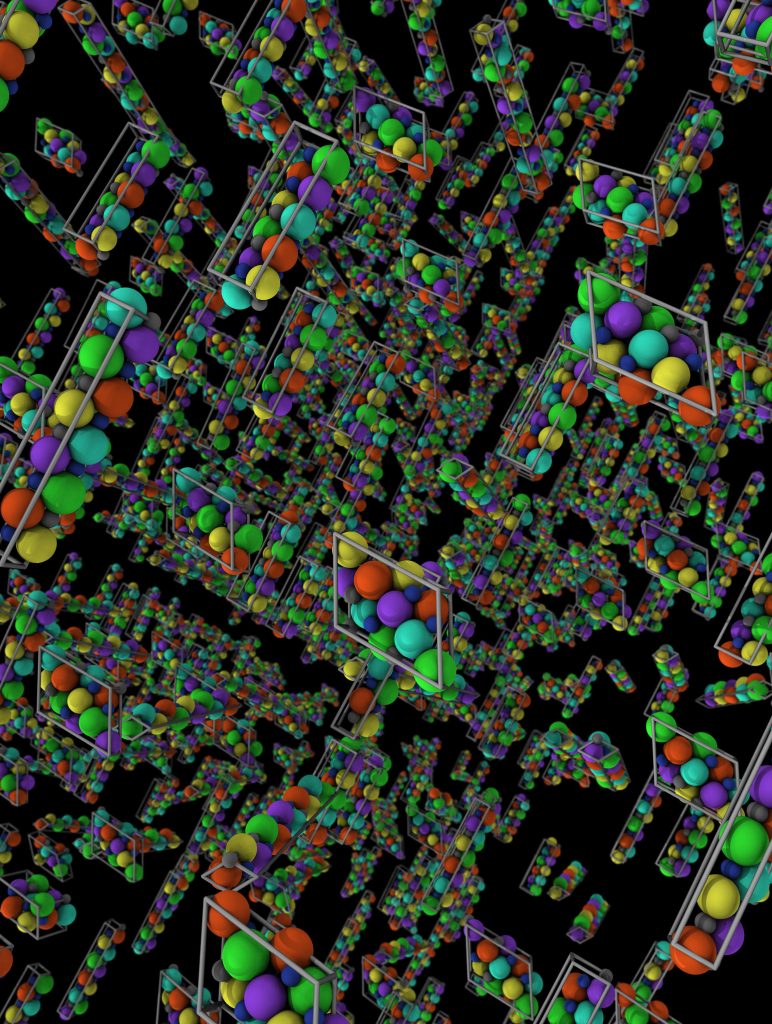
A novel computational technique has revealed hundreds of ceramic materials possessing a wide range of potentially industry-disrupting properties like electronics that could function in a lava bath
If you have a deep-seated, nagging worry over dropping your phone in molten lava, you’re in luck.
A research team led by materials scientists at Duke University has developed a method for rapidly discovering a new class of materials with heat and electronic tolerances so rugged that they that could enable devices to function at lava-like temperatures above several thousands of degrees Fahrenheit.
Harder than steel and stable in chemically corrosive environments, these materials could also form the basis of new wear- and corrosion-resistant coatings, thermoelectrics, batteries, catalysts, and radiation-resistant devices.
The Discovery Process
The recipes for these materials — ceramics made using transition metals carbonitrides or borides — were discovered through a new computational method called Disordered Enthalpy-Entropy Descriptor (DEED). In its first demonstration, the program predicted the synthesizability of 900 new formulations of high-performance materials, 17 of which were then tested and successfully produced in laboratories.
The results were recently published in the journal Nature and include contributions from collaborators at Penn State University, Missouri University of Science and Technology, North Carolina State University, and State University of New York at Buffalo.
“The capability of rapidly discovering synthesizable compositions will allow researchers to focus on optimizing their industry-disrupting properties,” said Stefano Curtarolo, the Edmund T. Pratt Jr. School Distinguished Professor of Mechanical Engineering and Materials Science at Duke.
The Role of DEED
The Curtarolo group maintains the Duke Automatic-FLOW for Materials Database (AFLOW)—an enormous reservoir of material properties data connected to many online tools for materials optimization. This wealth of information allows algorithms to accurately predict the properties of unexplored mixtures without having to attempt to simulate the complexities of atomic dynamics or make them in the laboratory.
For the past several years, the Curtarolo group has been working to develop predictive powers for “high-entropy” materials that derive enhanced stability from a chaotic mixture of atoms rather than relying solely on the orderly atomic structure of conventional materials. In 2018, they discovered high-entropy carbides, which were a simpler, special-case scenario.
“The high-entropy carbides all had a relatively uniform amount of enthalpy, so we could ignore part of the equation,” Curtarolo said. “But to predict new ceramic recipes with other transition metals, we had to address the enthalpy.”
To better understand the concepts of entropy and enthalpy in this application, think of a 10-year-old trying to construct a doghouse out of a giant pile of Legos. Even with limited types of building blocks, there would be many possible design outcomes.
In simple terms, enthalpy is a measure of how sturdy each design is, and entropy a measure of the number of possible designs that all have similar strength. The first promotes ordered configurations, like those that might be found in instruction booklets. The latter captures the unavoidable chaos that would occur as the child puts more time and energy into the increasingly confusing construction effort. Both are a measure of the amount of energy and heat that end up being absorbed into the final product.
“To rapidly quantify both enthalpy and entropy, we had to calculate the energy contained within the hundreds of thousands of various combinations of ingredients that we could potentially create instead of the ceramics we’re looking for,” Curtarolo said. “It was a mammoth undertaking.”
Besides predicting new recipes for stable disordered ceramics, DEED also helps direct their further analysis to discover their inherent properties. To find the optimal ceramics for various applications, researchers will need to refine these calculations and physically test them in laboratories.
The Synthesis Challenge
DEED is specifically tailored to a production method called hot-pressed sintering. This involves taking powdered forms of the constituent compounds and heating them in a vacuum to as high as 4000 degrees Fahrenheit while applying pressure for times that can be as long as a few hours. Between all the preparation, reaction, and cooling times, the entire process takes more than eight hours.
“The final step in synthesis, called spark plasma sintering, is an emerging method in materials science that is common in research labs,” said William Fahrenholtz, the Curators’ Distinguished Professor of Ceramic Engineering at Missouri S&T.
The finished ceramics have a metallic appearance and look dark grey or black. They feel like metal alloys such as stainless steel and have a similar density, but they are much darker in appearance. And even though they appear metallic, they are hard and brittle like conventional ceramics.
Moving forward, the group expects other researchers to begin using DEED to synthesize and test the properties of new ceramic materials for various applications. Given the incredible array of potential properties and uses, they believe it’s only a matter of time before some of them enter commercial production.
“Spark plasma sintering or field-assisted sintering technology (FAST) is not a common technique in industry yet,” added Doug Wolfe, professor of materials science and engineering and associate vice president for research at Penn State. “However, current ceramic manufacturers could pivot to making these materials by making small adjustments to existing processes and facilities.”
Reference: “Disordered enthalpy–entropy descriptor for high-entropy ceramics discovery” by Simon Divilov, Hagen Eckert, David Hicks, Corey Oses, Cormac Toher, Rico Friedrich, Marco Esters, Michael J. Mehl, Adam C. Zettel, Yoav Lederer, Eva Zurek, Jon-Paul Maria, Donald W. Brenner, Xiomara Campilongo, Suzana Filipović, William G. Fahrenholtz, Caillin J. Ryan, Christopher M. DeSalle, Ryan J. Crealese, Douglas E. Wolfe, Arrigo Calzolari and Stefano Curtarolo, 3 January 2024, Nature.
DOI: 10.1038/s41586-023-06786-y
This research was primarily supported by a five-year, $7.5 million grant through the US Department of Defense’s Multidisciplinary University Research Initiative (MURI) competition led by Curtarolo (N00014-21-1-2515, N00014-23-1-2615) and the Department of Defense High Performance Computing Modernization Program (HPC-Frontier).
Never miss a breakthrough: Join the SciTechDaily newsletter.